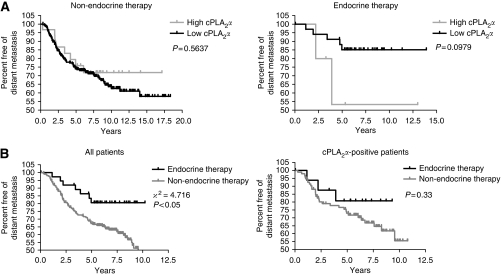Figure 5.
Role of cPLA2α in the early development of endocrine resistance in 295 breast cancer patients. Kaplan–Meier analysis of the probability that patients would remain free of distant metastases (A) among patients treated only with radiotherapy/chemotherapy and patients treated with adjuvant tamoxifen therapy, according to cPLA2α expression (high, n=31 vs low, n=224 for radio/chemotherapy and high, n=5 vs low, n=35 for adjuvant therapy), total follow-up time of 17 years; (B) among all patients or patients with high cPLA2α expression, according to the presence or absence of adjuvant endocrine therapy (non-endocrine, n=203 vs endocrine, n=38 for all patients; non-endocrine, n=94 vs endocrine, n=17 for cPLA2α positive patients), follow-up time of 10 years; (A and B) Survival curves were compared using the Cox–Mantel log-rank test. The corresponding χ2 values and P-values are indicated. The threshold for cPLA2α dichotomisation in (B) was lowered to the median in order to include more patients; the statistical significance was retained as compared with the analysis with the median cutoff point (not shown), suggesting the absence of bias because of the low number of patients.

